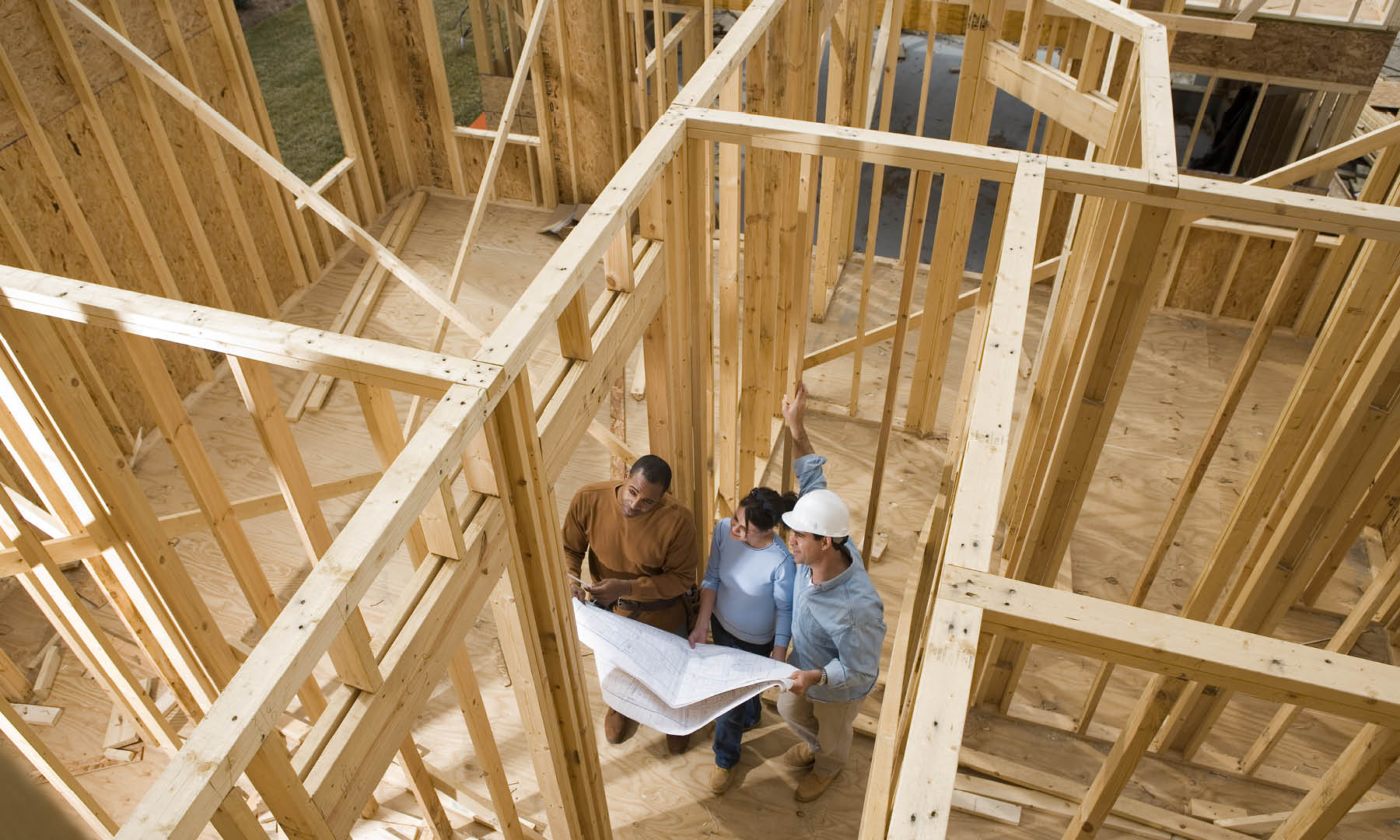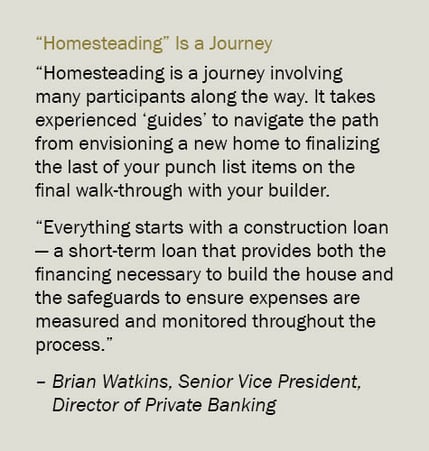
Admit it — you’ve dreamed about it for years. You’ve always wanted to build a custom home on that perfect piece of property — a house that reflects your taste and unique desires down to the last detail. If you’re up for the challenge and ready for an adventure, “homesteading” from scratch on a piece of undeveloped land can be the experience of a lifetime.
“So where do I begin?” you ask. Building a custom home can be very complicated and expensive. That’s why you may want to use a construction loan (a legitimate financial tool) to turn your dream into reality. In fact, a construction loan may be the only loan you’ll ever apply for on an asset that doesn’t exist — not yet anyway!
Construction loans are utilized for a variety of purposes: primary residences or vacation homes. They can also be used for local tear-down/rebuild projects that are popular these days as well. We’ve all seen larger homes or houses with more amenities built to replace older structures in highly sought-after locations and premium neighborhoods.

How do you get a construction loan?
To acquire a construction loan, an aspiring home builder usually starts off with architectural plans as the basis for estimating the projected value of the finished dream house. Once your plans are approved and accepted by all interested parties, construction loan providers generally offer you a loan based on a percentage of the completed, projected value of the house. As a rule of thumb, the construction loan providers will require you (the borrower) to make a 20% down payment, leaving a remaining loan value of approximately 80% of the projected value to provide the funds necessary to build your new home.
What’s the next step?
This is the point where your homestead journey can get a bit complicated. Construction loan providers don’t just hand over a lump sum to you. Instead, they disperse the loan funds in installments (called “draws”) as needed during various stages of your construction project.
For instance, a concrete contractor will likely request payment after foundations are poured and set. As the construction progresses, other building trade contractors — such as brick layers, carpenters, roofers, plumbers, electricians and painters — will want payment for the services they provided. Likely there are additional costs for other items such as property titling, inspections, appraisals, landscaping and interior finishing millwork.
A typical custom-built home can take 6-18 months to build — perhaps longer in an economy plagued by supply issues and labor shortages. There will be many check points to navigate payment dispersals, and they are specifically designed to ensure no stalls or delays occur during the progress of your home’s construction. Your construction loan provider should be your ally from the first building blueprints to the final walk-through of your completed home.
Construction loans are utilized for a variety of purposes: primary residences or vacation homes. They can also be used for local tear-down/rebuild projects that are popular these days as well. We’ve all seen larger homes or houses with more amenities built to replace older structures in highly sought-after locations and premium neighborhoods.

How do you get a construction loan?
To acquire a construction loan, an aspiring home builder usually starts off with architectural plans as the basis for estimating the projected value of the finished dream house. Once your plans are approved and accepted by all interested parties, construction loan providers generally offer you a loan based on a percentage of the completed, projected value of the house. As a rule of thumb, the construction loan providers will require you (the borrower) to make a 20% down payment, leaving a remaining loan value of approximately 80% of the projected value to provide the funds necessary to build your new home.
What’s the next step?
This is the point where your homestead journey can get a bit complicated. Construction loan providers don’t just hand over a lump sum to you. Instead, they disperse the loan funds in installments (called “draws”) as needed during various stages of your construction project.
For instance, a concrete contractor will likely request payment after foundations are poured and set. As the construction progresses, other building trade contractors — such as brick layers, carpenters, roofers, plumbers, electricians and painters — will want payment for the services they provided. Likely there are additional costs for other items such as property titling, inspections, appraisals, landscaping and interior finishing millwork.
A typical custom-built home can take 6-18 months to build — perhaps longer in an economy plagued by supply issues and labor shortages. There will be many check points to navigate payment dispersals, and they are specifically designed to ensure no stalls or delays occur during the progress of your home’s construction. Your construction loan provider should be your ally from the first building blueprints to the final walk-through of your completed home.
Contact us today to discuss a Construction Loan
What happens when the construction is finished?
When the building phase is completed, the construction loan is paid back immediately when a more traditional long-term mortgage is put in place. Provided you had no cost overruns and your home appraises at the original projected value, obtaining the mortgage loan financing is not nearly as arduous a process.
Some loan providers offer a financing package that includes both the construction and mortgage loan. Some lenders may offer to lock in the interest rate for the long-term mortgage financing in advance while the home is being built. With this feature, if interest rates rise during your construction phase, you will already know that your mortgage financing remains stable.
We can help.
Building a custom residence involves many contributors to guide you along the way — especially if you need to take out a short-term loan for construction and a second, longer-term mortgage to permanently finance your new home once the project is complete. It’s good to have an experienced advisor help navigate the financial crossroads on the way to making your dream home a reality. For those interested in discussing a construction loan as an option, contact Commerce Trust today.

Past performance is no guarantee of future results. The opinions and other information in the commentary are provided as of August 17, 2022. This summary is intended to provide general information only, and may be of value to the reader and audience.
This material is not a recommendation of any particular investment or insurance strategy, is not based on any particular financial situation or need, and is not intended to replace the advice of a qualified tax advisor or investment professional. While Commerce may provide information or express opinions from time to time, such information or opinions are subject to change, are not offered as professional tax, insurance or legal advice, and may not be relied on as such. Commerce does not provide tax advice or legal advice to customers. Consult a tax specialist regarding tax implications related to any product and specific financial situation.
Data contained herein from third-party providers is obtained from what are considered reliable sources. However, its accuracy, completeness or reliability cannot be guaranteed.
The Private Bank at Commerce Trust is a business unit of Commerce Trust, a division of Commerce Bank.
What happens when the construction is finished?
When the building phase is completed, the construction loan is paid back immediately when a more traditional long-term mortgage is put in place. Provided you had no cost overruns and your home appraises at the original projected value, obtaining the mortgage loan financing is not nearly as arduous a process.
Some loan providers offer a financing package that includes both the construction and mortgage loan. Some lenders may offer to lock in the interest rate for the long-term mortgage financing in advance while the home is being built. With this feature, if interest rates rise during your construction phase, you will already know that your mortgage financing remains stable.
We can help.
Building a custom residence involves many contributors to guide you along the way — especially if you need to take out a short-term loan for construction and a second, longer-term mortgage to permanently finance your new home once the project is complete. It’s good to have an experienced advisor help navigate the financial crossroads on the way to making your dream home a reality. For those interested in discussing a construction loan as an option, contact Commerce Trust today.

Past performance is no guarantee of future results. The opinions and other information in the commentary are provided as of August 17, 2022. This summary is intended to provide general information only, and may be of value to the reader and audience.
This material is not a recommendation of any particular investment or insurance strategy, is not based on any particular financial situation or need, and is not intended to replace the advice of a qualified tax advisor or investment professional. While Commerce may provide information or express opinions from time to time, such information or opinions are subject to change, are not offered as professional tax, insurance or legal advice, and may not be relied on as such. Commerce does not provide tax advice or legal advice to customers. Consult a tax specialist regarding tax implications related to any product and specific financial situation.
Data contained herein from third-party providers is obtained from what are considered reliable sources. However, its accuracy, completeness or reliability cannot be guaranteed.
The Private Bank at Commerce Trust is a business unit of Commerce Trust, a division of Commerce Bank.

 Brian Watkins
Brian Watkins